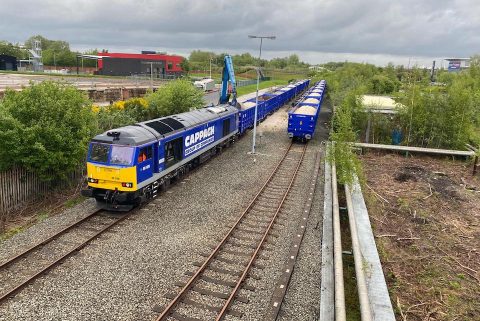Mega-project CPK moves forward, freight elements are being defined

Poland’s largest infrastructure project, the Centralny Port Komunikacyjny (CPK), aiming to bring together air, road, freight and passenger rail operations in a single hub, is taking decisive steps towards its implementation. Land purchases and excavations are underway, and CPK’s final location will soon be determined. Most importantly, the company is defining how the different transport modes will coexist within the hub and also in Polish infrastructure. For rail freight, preparations focus primarily on the transport model to be used and the planning of intermodal transport and relevant locations.
CPK mentioned that “large-scale geological excavations, as well as demolition and removal works, are already underway at the CPK airport investment site,” but also on several other smaller sites, which will either become rail stations for passenger traffic or terminals for intermodal freight traffic. The company is also ready to apply to the local government, the Mazovian Voivode, to decide the hub’s definite location. The expectation is that by the end of the year, CPK will acquire permission, which will allow it to apply for and obtain a building permit.
“So far, over 1,000 hectares of land have been purchased CPK under the Voluntary Acquisition Programme (PDN). The procedure for selecting a financial partner for the airport has also now entered a decisive phase,” said CPK. The financial partner is important because, as Mikołaj Wild, CEO of CPK, explained, “the investment will be financed 60 per cent via debt financing (e.g. bonds, loans) and 40 per cent via private capital from the company managing the airport. This company will have two shareholders. The financial partner will control a maximum of 49 per cent share, and the State Treasury will provide the remaining 51 per cent.”
What’s there for rail freight?
Wild highlighted before that “rail freight will be a vital component of CPK’s operations as it is an essential element of the hub’s mixed passenger-cargo transport concept”. Most of the CPK railway infrastructure will be high-speed, thus targeting passenger services primarily. However, it will be able to accommodate lighter freight trains in most parts that can be included in the train schedule as shuttle trains. “These will be, in particular, intermodal trains carrying containers and semi-trailers”, added Wild.
The CPK aims to build a rail freight terminal within the airport’s vicinity to facilitate rail cargo transport. “The terminal will serve the airport and freight trains waiting for slots at CPK railway lines. It will also have a track dedicated to roll-on/roll-off road-rail transhipment of semi-trailers”, he highlighted.
On top of that, several intermodal terminals will be built along CPK’s high-speed rail network. The company underlined that “on many sections of the planned lines, there is great potential for combining passenger traffic with rail freight in a model known as mixed.” Its approach entails reserving space where needed for the construction of terminals that will be able to accommodate 750-metre-long trains and facilitate both vertical and horizontal loading. One such terminal could be built on the new Katowice-Ostrava line.
Special transport model
Understandably, bundling so many different transport modes and making their operations efficient and flowing is a significant challenge that has not been addressed before in Europe. Maybe this is why Andrzej Duda, President of the Republic of Poland, framed the project as “one of the most important that Poland is carrying out in the 21st century.” However, what is even more important is building infrastructure in a targeted manner that will allow the proper operation of all modes, including rail.
For rail freight specifically, CPK will implement the TMT freight transport model to address this issue and ensure that infrastructure, including lines and terminals, will be developed in accordance with the industry’s needs.
The company explained that TMT covers all transport modes (rail, road, air and maritime) and is “the first comprehensive tool in Poland for freight traffic analysis.” The idea behind this solution is that it will provide a comprehensive understanding of all the different supply chains involved in terms of competitiveness and freight handling. In this way, it will be possible to assess and calculate domestic and international freight movements and, based on the traffic volumes, determine how rail infrastructure will develop regarding its dimensions, for instance, to serve freight traffic and lightweight intermodal trains.
Also read:





